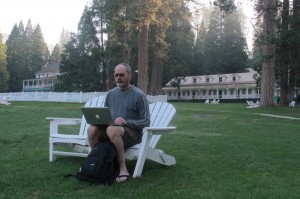Culture – Ambiguity and Anxiety

Dessert! Why wait?
The future is uncertain. Eat dessert first.
If you act on this sage advice, you may well come from a culture that’s high on the Uncertainty Avoidance Index (UAI). As Geert and Gert Jan Hofstede have pointed out, the desire to avoid uncertainty varies dramatically from culture to culture and fundamentally affects how people think and behave.
The Hofstedes (father and son) study the influence of national cultures on organizational behavior. They write that there are five basic dimensions of culture: 1) power distance; 2) individualist/ collectivist; 3) masculine/feminine; 4) Uncertainty avoidance; 5) short-term/long-term orientation. I’ve written about the first three previously (here, here, and here). Today, let’s talk about uncertainty avoidance.
The Uncertainty Avoidance Index measures the degree to which a culture believes that what’s different is dangerous. Countries with high UAIs tend to be anxious about ambiguity and the future in general. They often establish laws, behavioral codes, religions, and technologies that reduce ambiguity. Countries with high UAIs include Greece (UAI = 114), Poland (93), Japan (92), France (86), South Korea (85), Israel (81), and Italy (75).
Countries with low UAIs tend to believe that what’s difference is curious. They are generally less rules-oriented and less anxious about the future. They tend to see the world as a relatively benevolent place and to give the benefit of the doubt to new ideas, situations, and people. Countries with low UAIs include the United States (46), India (40), Great Britain (35), Ireland (35), Sweden (29), and Denmark (23).
Uncertainty avoidance expresses itself in many different ways. Very generally speaking, families in affluent countries with high UAIs have fewer children than those in affluent countries with low UA indexes. People in high UAI cultures tend to be more stressed and rules for children are quite firm. People in low UAI culture tend to be more agreeable and more blasé about children’s play habits. They worry less about health and money.
Let’s say you want to market a product internationally, including both low and high UAI countries. Your message will need to be very different. In high UAI countries, consumers will want to know about the purity and cleanliness of the product. They also value expert opinion in their advertising. In low UAI countries, consumers tend to seek convenience rather than purity and prefer humorous ads.
Similarly, consumers in low UAI countries find used cars acceptable and are more likely to be do-it-yourself enthusiasts. They also tend to be early adopters of new technologies. Consumers in high UAI countries tend to prefer new cars and hire experts to do their home repairs. They’re also slower to adopt new technologies.
In the workplace, differences are equally pronounced. High UAI cultures emphasize the importance of rules – even those that are not obeyed. They also prefer more structure, precision, and formality. Managers should be technical experts and tend to focus on daily operations.
Low UAI cultures have fewer rules in the workplace and value managers who are known more for common sense than technical expertise. Managers focus more on strategy than daily operations. Low UAI workplaces tend to be better at inventing new processes but high UAI workplaces are better at implementing them.
It’s a very interesting mix, especially when you combine uncertainty with masculinity, individualism, and power distance. To learn more, get the Hofstede’s book.
Critical Thinking and the Job Market

Because I know how to think.
I used to teach research methods, which is about creating knowledge. Now I teach critical thinking, which is about assessing knowledge. How do we know what we know and how can we assess knowledge in an objective, fairminded way?
It’s a fun course because we think about thinking. We discuss everything from egocentrism to reason, logic, ethics, media bias, and unfair ways to win an argument. Many of the students challenge their own beliefs and we all challenge each other. It’s a stimulating way to learn to think clearly and to avoid getting bamboozled.
What surprises me about the class is how surprised the students are. Even though much of the course is applied common sense, they’ve rarely thought of this before. That concerns me because these are Master’s students. All of them have at least four years of undergraduate study. Yet they haven’t thought about how to think. Here are some quotes from recent student papers:
I never thought to think about thinking
It is revolutionary for me to understand that there is an analytical process called critical thinking that I can [use] to systematically develop clearer thinking…
… while I practiced some critical thinking basics, I had really only scratched the surface
This class taught me that I was unconscious of the connection between my thoughts and emotions.
It was not required in my undergraduate program and I have never taken a class similar to it.
So, I’ve been asking myself, why aren’t we teaching college students how to think? My Mom always told me that the purpose of college was to learn how to think. Was she wrong or have we given up on that objective?
When I was in undergraduate school, the first two years of our four-year curriculum were given over to “general education”. We didn’t start to specialize in our major – finance or engineering or anthropology – until the third year. Today, it seems that general education has simply evaporated. Students start specializing as soon as they land on campus.
So when do they learn to think? If a finance major takes four years of accounting courses, what do they really gain, other than an exceedingly narrow view of the world? I wonder if we haven’t gone too far in the direction of preparing students for the job market. We identify the technical skills the market requires – accounting, programming, etc. – but not the thinking skills.
Do companies really want ace spreadsheet jockeys who don’t know how to evaluate whether an assumption is logical or not? As someone who hired several hundred people in my career, I would say no. I preferred hiring people who can think clearly and communicate effectively. The rest is trivial.
So, I’m all in favor of bringing back general education and teaching students how to think. I’m not sure how to go about it but I’m developing a theory that the MOOCs will help get us back to basics. That may be the silver lining in the coming wave of MOOC disruption.
Seven Leadership Styles

Alchemist
I’ve often thought of leadership as the ability to motivate people to work together toward a common goal. My definition is not far from Dwight Eisenhower’s quote: “Leadership is getting people to do something because they want to do it.”
Of course, there are different tactics to use in different situations. I study rhetoric – the art and science of persuasion – because I find it very helpful in convincing people that they want to do something. I also like to lay out goals and make them clear as possible. I’m not much of a yeller but I can understand (intellectually at least) how yelling might be a good leadership tactic in some situations – like an emergency.
I hadn’t thought much beyond that, so it was good to rediscover a 2005 Harvard Business Review article titled “Seven Transformations of Leadership”. The authors, David Rooke and William Torbert, identify seven “action logics” that can help us understand what kind of leader we already are.
I’ll summarize the seven here – using Rooke and Torbert’s terminology – partially because I think they’re important but also because I want to refer back to them in future posts.
Opportunists – “characterized by mistrust, egocentrism, and manipulativeness”, their goal is to win in any way possible. Only 5% of leaders are deemed to be opportunists (thankfully).
Diplomats – “seeks to please higher-level colleagues while avoiding conflict.” They rarely rock the boat and comprise about 12% of leaders.
Experts – “try to exercise control by perfecting their knowledge … watertight thinking is extremely important.” Experts comprise the largest single group of leaders, about 38%.
Achievers — “create a positive work environment and focus … on deliverables, the downside is that their style often inhibits thinking outside the box.” About 30% of leaders are achievers.
Individualists – often seen as “wild cards” with “unique and unconventional ways of operating”. Yet they also “contribute unique practical value” and “communicate well with people who have other action logics.” They make up about 10% of leaders.
Strategists – “focus on organizational constraints and perceptions, which they treat as discussable and transformable.” They are “highly effective change agents” but account for only 4% of leaders.
Alchemists – are able to “renew or reinvent themselves in historically significant ways.” They have “an extraordinary capacity to deal simultaneously with many situations at multiple levels.” Rooke and Torbert identify Nelson Mandela as an exemplar of the alchemist, which may help explain why only 1% of leaders fit the category.
Fran and Grover in Hawaii
 Today would be my parent’s 72nd wedding anniversary. That they got married on June 8, 1941 was something of an accident.
Today would be my parent’s 72nd wedding anniversary. That they got married on June 8, 1941 was something of an accident.
Fran and Grover grew up in small towns in southeastern Texas. Fran’s father died when she was nine and Fran grew up very close to the poverty line. Grover was a bit better off; his father was involved in local politics and small businesses.
Grover could afford to go to the local college, Texas A&M. At the time, A&M was an all-male, military school. Every student was in the “Corps” (ROTC), received extensive military training, and a commission as a 2nd lieutenant upon graduation. Graduates served a minimum of two years in the military.
Fran worked as a secretary at A&M. They met and dated for several years. Ultimately, Grover asked her to marry him. She turned him down, saying that she didn’t want to be a military wife. She did leave an opening though, suggesting that Grover go off, do his tour of duty and then come back home to see if she were still available.
Grover graduated as en electrical engineer but wasn’t deployed immediately. Finally, in late May 1941 he got his orders – he was being deployed to Hawaii. He went back to Fran and said, in essence, “Marry me now and I’ll take you to Hawaii.” Fran said, “Well… if that’s the way you put it … OK.”
They had to quickly organize a wedding; Grover had to ship out shortly. The church happened to be available on June 8, so they took the slot. Apparently they didn’t have time to arrange a photographer; I’ve never seen a picture of their wedding. They spent their honeymoon driving from Bryan, Texas to San Francisco where they shipped out (on the S.S. Lurleen) to Hawaii.
And that’s how they both wound up at Pearl Harbor.
MOOCs and Me – 2

I can teach from anywhere.
So, what about it? Will MOOCs destroy academic life as we know it? Or will they be more like correspondence courses – an interesting niche but only a niche? As a teacher of MOOC-like courses, I do have an opinion. (See yesterday’s post for the background to this burning question).
Here’s what MOOCs are good for: transferring structured bodies of information and testing to see that it was accurately received. Actually, the testing is still a bit slippery. It’s not always clear who is actually taking the test. However, I think that will be worked out over the next couple of years with proctored exams and/or new forms of identification.
Here’s what classroom-based education is good for: growing up. MOOCs can’t teach you much about integrity, social interaction, clear thinking, mature judgment, and the responsibilities of adult life. Campus education – especially residential campus education – can teach you far more about living than MOOCs ever could. As David Brooks points out, morality is a group activity.
People who want to grow up will continue to choose campus-oriented higher education. People who want to earn professional credentials may find MOOCs are a much better choice.
What does this mean in practice? I think undergraduate schools will be relatively unaffected by MOOCs. There will always be good reasons to ship your kids off to college.
Further, some skills are more readily taught face-to-face, including negotiation, mediation, critical thinking, disputation, public speaking, rhetoric, and writing. Undergraduate schools will place increasing emphasis on these foundational skills. In this sense, they’ll be more like colleges of the 1930s and 40s than those of the 1980s and 90s.
Graduate education, on the other hand, is about to get Amazoned. Why would a student take a course in, say artificial intelligence, from a local professor when they could cover the same material (for free) from a world-renowned expert? When it comes to transferring a structured body of knowledge, MOOCs are hard to beat.
Is there any value of going to graduate school on campus? Well, foundational skills are still important. I teach Master’s students and I can attest that they would benefit by improving their ability to negotiate, speak persuasively, and write effectively. Additionally, on-campus programs may be better at helping students develop life-long networks. Actually, I’m a little skeptical that this is a significant advantage – social networks can fill the same need. Still, there’s probably a modest benefit from meeting your co-conspirators on campus.
To survive, I think that many graduate schools will shift their emphasis away from codified bodies of knowledge and toward the foundational skills. They can offer the bodies of knowledge through MOOCs. In their on-campus courses, they’ll focus on teaching the “softer” skills. In my experience, these are far more valuable than structured bodies of knowledge.
In terms of market positioning, I think it’s simple. The best grad schools in the future will position themselves along these lines: Any MOOC can teach you how the world works. We can also teach you how to work in the world.
(By the way, these opinions are my own and not those of any of my clients or employers).